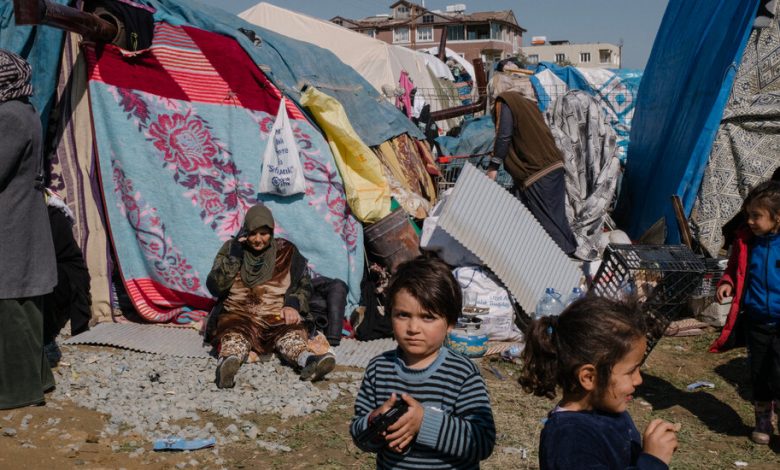Caves, Tents and Shipping Containers: Quake Survivors’ Desperate Hunt for Shelter

Two weeks ago, Lutfiye Yuce hosted a 30th birthday party for her daughter Yesim in the southern Turkish city of Antakya. She bought an iced cake and invited a handful of neighbors.
Three days later, the neighbors returned in the middle of the night to untangle Yesim from under her home, which had caved into the shaking mountainside that cradles the city.
“It was as if the ground was boiling,” said Ms. Yuce, 66, recalling how the earth shuddered as her son carried her daughter’s body down from the mountain.
She and her son sheltered in a cave for days before joining neighbors in a tent encampment beside an ancient monastery. They are among an estimated one million Turkish people left homeless by the earthquake this month that decimated a wide swath of Turkey and western Syria.
“I had everything, and I now I have nothing,” said Ms. Yuce, who noted that she had also lost a son in the earthquake. She has four surviving children, she said, and they are all homeless. “I can never return there again — but what can I do, I have nowhere to go.”
Nearly 40,000 people in Turkey died in the earthquake and a powerful aftershock. About 47,000 buildings were destroyed or damaged, sending more than one million people into temporary shelters, according to the International Rescue Committee. And millions more remain in need of food, shelter, electricity, water and toilets. Many have spent almost two weeks in the open air, sometimes braving freezing weather.
The Turkish government, along with relief workers from agencies like the Red Crescent and the U.N.H.C.R., the United Nations refugee agency, are scrambling to meet the herculean challenge of housing people across quake-stricken areas of Turkey.
A park in the city of Adiyaman has become a distribution point for survivors, packed with tents set up by the Turkish national emergency management agency, AFAD. The picnic areas are full of volunteers cooking giant vats of soup, while others hand out water, diapers, blankets, milk, cookies and nonperishable food.
Deadly Quake in Turkey and Syria
A 7.8-magnitude earthquake on Feb. 6, with its epicenter in Gaziantep, Turkey, has become one of the deadliest natural disasters of the century.
- Near the Epicenter: Amid scenes of utter devastation in the ancient Turkish city of Antakya, thousands are trying to make sense of an earthquake that left them with no home and no future.
- A Flawed Design: Residents of a new upscale tower in Turkey were told it was earthquake resistant, but the building collapsed anyway. A close look offers clues as to why.
- Miraculous Rescues: Two brothers who rationed protein powder while trapped under the rubble of a collapsed building for about 200 hours were among those rescued in Turkey a week after the quake.
- Isolation and Resignation: Some villages in rural southern Turkey, some villages were cut off from aid for days after the quake. Locals were left to fend for themselves.
Resting under some trees was Erdal Akaslan and his wife, Selman Akaslan. The house where they lived with their three children had been damaged in the earthquake, so they were outside for a day before Mr. Akaslan found plastic sheeting and wood beams to build a makeshift tent in an empty lot. They had not been able to get an AFAD tent.
“I asked 50 times and could not get a tent,” he said.
Also in Adiyaman, Kadir Erdil, 60, a shopkeeper whose house was badly damaged in the quake, said he had moved with his wife and their three adult children to a garden with no buildings nearby that could fall on them.
“We have a couple of blankets and carpets to lay on,” he said, “but at night, they are not enough to stop the cold.”
Conditions are generally worse for many of the 3.6 million Syrian refugees who live in the quake zone in Turkey.
In the town of Besni, Mohammed Makhzoum, 31, said he, his wife and their three children had barely escaped their house during the earthquake. They met up with other Syrian families in their area, and many of them settled at the tree nursery where Mr. Makhzoum worked.
There were multiple families there, and he estimated that scores of women and children were packed into the nursery’s three-room building. For the first few nights, the men and boys stayed uncovered outside, but then the nursery owner brought them a large tent to sleep in.
They were in a small town, and received no aid from the government.
In response to growing public frustration over his government’s relief efforts, President Recep Tayyip Erdogan has said he intends to construct enough “high-quality and safe buildings within one year” in order to “meet the housing needs across the entire earthquake zone.”
For now, the government is relying on a raft of short-term solutions: Repurposed shipping containers are popping up like impromptu trailer parks. Gymnasiums, hotels and university dormitories have been packed with people. A cruise ship is set to arrive in the port city of Iskenderun to accommodate thousands of other Syrian refugees in Turkey.
The road out of Antakya offers a panorama of the outpouring of support for survivors. Cars piled with bags of clothing from local charities weave around tractors pushing debris. Mobile kitchens advertising soup and tea trail ambulances and trucks stacked with sacks of rice and flour.
Across the ruined landscape, in parks and other open areas, tents and makeshift shelters displaying lettering from aid groups jut out from the rubble.
More formal camps have been set up by AFAD in parking lots throughout Antakya. They offer some of the best conditions those in the quake zone can hope for: The tents are made of thick, waterproof fabric and have wood or coal-burning heaters.
But receiving a tent is a privilege not everyone is granted.
“We are only Turkish families here,” said Nedime Sahin, 24, who had been living for five days in an AFAD camp housing about 1,200 people outside a stadium. “There were Syrians before we moved in here, but they were forced to leave.”
Near the stadium, a young girl and boy pushed a cart of donated clothes and toys from a mosque to an olive grove, where an extended family of 150 Syrians had set up tents just beyond the shadow of the building complex where they once lived.
“AFAD refused to give us tents, so we made our own,” said Mohammed Kasim Khadijeh, 23. His family’s shelter was topped with rugs and tarpaulins. Spare furniture was set outside, along with pots and other belongings that Mr. Khadijeh had retrieved from his apartment.
“Life goes on,” said Mr. Khadijeh’s uncle, Sobhi Khadijeh, who escaped Syria’s civil war with his family eight years ago and had been working in construction before the quake. Now, he and his wife were eating only one meal a day to ensure their eight children had enough food. “There was a war in Syria. There was an earthquake in Turkey. But we are still alive.”
Even with the support from international humanitarian organizations, local aid groups and generous residents, some people, like the Khadijehs, had not received help, the uncle and nephew said. They were relying on food salvaged from their homes or sent by relatives who lived outside the quake zone.
Some volunteers had visited the family, toting aid across the country in their own cars. Dogukan Manco, 42, a disc jockey, drove over 11 hours from Istanbul and stopped in cities along the way to pick up water tanks and clothing, which he gave to the Syrians.
“I dropped everything to get here,” he said, adding that a number of his friends had fanned out across hard-hit regions in an effort to reach areas that aid groups like AFAD were not likely to visit.
So far, at least 368,874 tents have been sent to the quake zone, of which 172,265 have been erected, AFAD said on Thursday. The government has also repurposed 5,400 shipping containers for housing, and at least 890,000 people are being housed in state-run dormitories and facilities. About 50,000 victims are in hotels, Mr. Erdogan said on Tuesday.
In the city of Adana, about 80 miles from the quake’s epicenter, a vast network of gymnasiums, mosques and hotels have been transformed into shelters for tens of thousands of victims.
Omer Kahraman was one of hundreds of survivors who took refuge this past week at the Adana Garden Business Hotel.
“I am very pleased with Adana’s hospitality,” he said, as he lay amid a group of people gathered on cushions in the hotel’s softly lit ballroom. Mr. Kahraman said it had taken eight hours for rescue workers to extract him from the rubble of his six-story building in Kahramanmaras. He was flown to Adana by military helicopter so he could receive treatment for two broken legs.
“I made friends here I will not forget my entire life,” he said.
Others described being trapped in an infuriating limbo, shuttled from place to place as they waited for officials to confirm that their homes were safe to return to.
“Last week, we were in a swimming pool; now we are in a gym,” said Dilek Tekerlek, 48, lying on a thin mattress in a corner of a gym where her family has slept for the past five days.
More than a dozen families were sheltering at the gym in Adana, sleeping on rugs in small groups. Little feet and hands poked out from beneath thin blankets. Mothers scrolled on their cellphones, searching for news of others who were displaced or had disappeared beneath the rubble.
Flanked by a few suitcases, some plastic bags and three of her children, Ms. Tekerlek lamented that they would have to move soon.
“We are being told we will be forced to leave this place,” she said of the Turkish Sports Ministry, which had organized the shelter and declined to comment on where the families would taken. “We don’t know what’s next — we have nothing to return to.”
Ben Hubbard contributed reporting from Adiyaman, Turkey, Raja Abdulrahim from Adana, Turkey, and Gulsin Harman from Istanbul.




